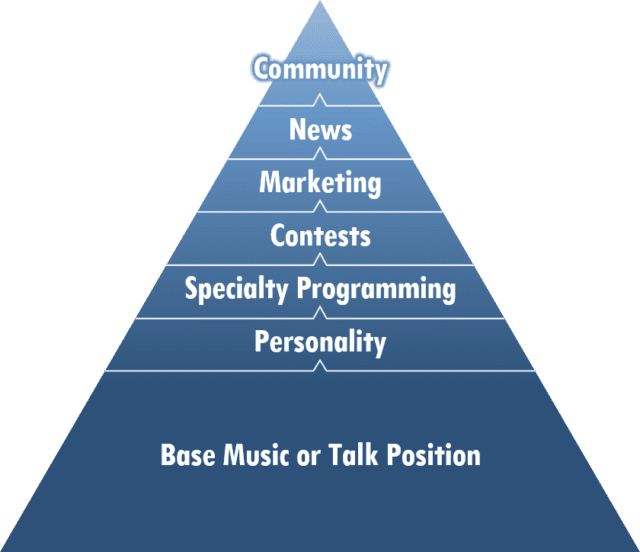
This simple illustration of layers that represent the way listeners perceive radio stations was introduced to the industry decades ago by our founder, Jon Coleman, and still guides our strategic work today.
But that doesn’t mean we don’t regularly think about the evolution of the Pyramid and how it applies as the medium (and how consumers use it) changes.

The foundation of the Pyramid is a station’s Base Music or Talk Position. Its importance is demonstrated by the largest amount of space and, as the base component, is responsible for holding everything up. Without a strong Base Position, successful radio stations are unable to build the other layers that provide essential brand depth.
It’s understandable, particularly in 2024, that the most common question we get about the Image Pyramid is whether the Personality layer and the Base Music Position should switch places, making Personality the foundational element. It is completely logical to consider the proliferation of options that consumers now have for music on platforms besides radio. Aren’t personalities radio’s greatest differentiator?
The answer to that question, of course, is yes.
Radio stations that have strong Base Music Positions—when listeners can clearly identify what kind of music they can expect from the brand—and have developed additional layers of the Pyramid often experience great success. These are the superstar stations that are known for playing appealing music that is expected of the brand and have personalities that make meaningful connections with their listeners. The best of the best also have appointment listening specialty programming, contests that move the needle and advance the brand and have top-of-mind marketing campaigns. These stations have listeners that tune in because they have FOMO if they don’t. They are entrenched in the fabric of their communities. They have deep brand loyalty and generally experience fewer ratings wobbles.
Can a radio station with a strong Base Music Position be successful without significant Personality images or other layers of the Pyramid? Yes, but it is a much tougher task, and successes tend to be short-term and like a rollercoaster.
So, Personality is clearly very important. But so is the music, and here’s why:
Think of a radio station’s music as the “access point”. The big tent. When you discover a new radio station you like, you probably already like or love the music it plays. Liking or loving a personality takes time. You fall in love with the music first. The personality is there a few hours a day, and the music is there nearly 24/7. It is truly the glue that holds it all together.
That’s also why new morning shows can benefit from playing a lot of music. When a new listener hears a show for the first time, it can feel intimidating when they aren’t in “the club”. It’s like jumping on the boat as it’s going down the river. Playing songs you already like with smaller doses of the morning show slows down the rapids, and gives you a chance to get to know the talent.
Even music radio stations with foreground personalities are often thought of for their music first. 102.3 Now! Radio in Edmonton is a hugely successful Hot AC station with all-day “conversations” that seep into its other platforms. A study of 102.3 Now! Radio conducted by Coleman Insights and Alan Burns and Associates indicated that most listeners choose the station for both music and conversations, with more of the station’s Cume citing “music” over “conversations”. As mentioned previously, Now! Radio’s music gives it license to grow personalities. If you are only focused on the non-music elements of your radio station, you may neglect the big Cume magnet that holds it all together.

We also get asked from time to time about how elements like social media, streaming, and apps fit into the Image Pyramid discussion. Our take is that the Image Pyramid is built based on the perceptions listeners have of radio stations, so these elements wouldn’t have their own layer. However, how these elements are utilized can absolutely impact existing layers.
For example, if a morning show is engaging and funny and has a disciplined video strategy for TikTok, Reels, and Shorts, that could positively impact the Personality layer. If a radio station’s social media director is positing Wendy’s level-content on Twitter (sorry…X..sigh), that could positively impact the Marketing layer.
As always, the most successful radio stations are the ones with the strongest, most developed, top-of-mind perceptions. While tactics may evolve, programming according to the foundation of the Image Pyramid and conducting strategic research to track impact and success is the best way to ensure consumers have deep, meaningful perceptions of their favorite audio brands.
Special thanks to Andy Reid in Australia for inspiring the subject matter of today’s Tuesdays With Coleman blog.
